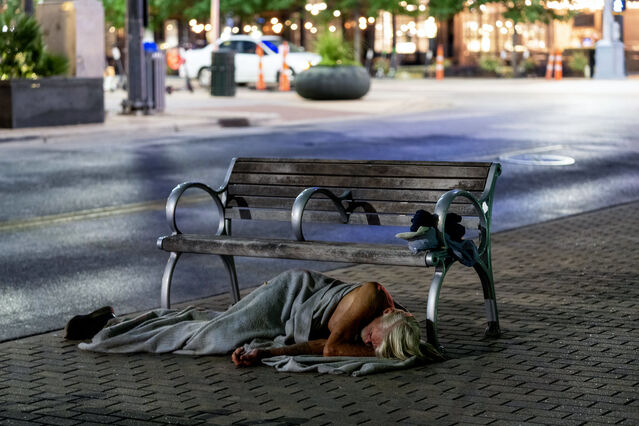Hostile architecture is advertised as a way to limit specific bad behaviour from people and animals. For example, it can be used as a way to prevent people from performing skateboarding tricks in public areas or birds from landing in trees. Ridiculous, I know. However, there is a more hateful but lesser known reason for the existence of the hostile architecture we can see across the world, Ontario, or even in Waterloo. The use of hostile architecture has been linked to creating inhabitable spaces for the unhoused, leading the architecture to be dubbed “anti-homeless architecture”. We see this in the different forms that hostile architecture takes: slanted benches, arm rests, “street spikes”, rocky pavements, breaks in awnings, boulders under bridges, curved benches, and more (McFadden, 2020). Each of these work towards creating uncomfortable or uninhabitable spaces in order to reduce the amount of homeless people resting or sleeping in public. This is typically conveyed to be a form of “cleaning up the streets”, but I, like many people, question whether this is a fact. Cleaning up the streets, to me, should mean reducing numbers of homelessness and poverty in the country, not creating more uncomfortable lives for those of a lower socioeconomic class. Not only do I feel it is inhumane to reduce the amount of places for the unhoused to rest, and that it is idiotic to change public spaces so that the general public find them less convenient to use, but I find it is incredibly hypocritical for specifically the University of Waterloo’s Engineering Faculty to allow this to continue within our reach.
In our classes, we repeatedly learn about grand challenges for engineers and the pillars that make up our community. One such grand challenge is “inclusive, safe, and sustainable cities” (Engineering Deans of Canada, 2021), which preaches the necessity to solve many different problems and directly mentions the need for “greater diversity of transportation, with affordable access for lower income communities”, as well as “creating inclusive cities” (Ibid). I find it ironic that lower income communities can be directly mentioned, but only acknowledged in a specific context. While it is definitely beneficial for there to be affordable transportation methods, I believe that inclusive cities should be a higher priority in general and directly relate to the unhoused, yet the grand challenges document cites “inclusive cities” to pertain solely to the aging population (Ibid). Creating inclusive cities should focus on the inclusion of everyone of different races, genders, ages, socioeconomic classes, and so on, not support only one facet of the population.
Additionally, part of being in the engineering community at the University of Waterloo means committing to a pledge which highlights a pillar of our community to be responsible. In fact, the Commitment Pledge states, “I will act with integrity, upholding the ethical standards of honesty, respect, and accountability” (University of Waterloo, 2023). What is ethical about removing a safer, more comfortable space for the unhoused? Where is our respect for the less fortunate people in our lives? Furthermore, the pledge continues with, “I will aspire to make a meaningful and positive impact on society and the land, recognizing that my decisions, actions, and stewardship will impact current and future generations” (Ibid). This underlines the fact that we have a responsibility to ensure that people from different socioeconomic classes have access to safe, affordable, and comfortable spaces to sleep, rest, and house themselves.
Do I believe we alone can fix such widespread problems such as hostile architecture and discrimination against those of lower socioeconomic classes? No, of course not, that is unreasonable. But I do believe that, in general, we should attempt to acknowledge and spread knowledge about the existence of hostile architecture, and do the best we can in our community to proceed into the workforce with the understanding that we are privileged and in positions of power, and that our actions can and will have effects on others, so we should make sure they are positive ones.
Works Cited
Engineering Deans Canada. Canadian Engineering Grand Challenges 2020-2030, 14 Apr. 2021, engineeringdeans.ca/en/project/cegc/.
McFadden, Christopher. “15 Examples of ‘anti-Homeless’ Hostile Architecture Common to Cities.” 15 Extreme Examples of “anti-Homeless” Hostile Architecture, Interesting Engineering, 8 Apr. 2023, interestingengineering.com/culture/15-examples-of-anti-homeless-hostile-architecture-that-you-probably-never-noticed-before.
University of Waterloo. “Commitment Pledge.” 2023.
Dragonite. “Homeless Person Sleeps on the Floor.” Psychology Today, Flickr, 2020, www.psychologytoday.com/intl/blog/modern-minds/202012/is-your-town-filled-hostile-architecture. Accessed 03 Nov. 2023.





Leave a Reply